人教版新目标版七年级英语上册 写作训练课教学设计3
- 格式:doc
- 大小:90.00 KB
- 文档页数:3
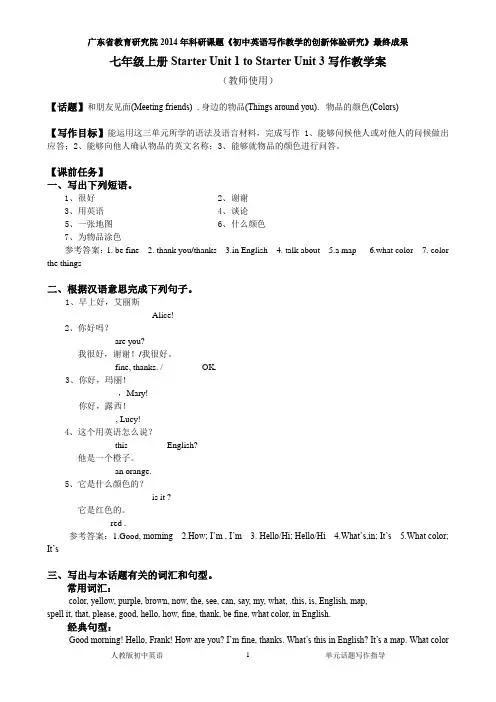
七年级上册Starter Unit 1 to Starter Unit 3写作教学案(教师使用)【话题】和朋友见面(Meeting friends) .身边的物品(Things around you). 物品的颜色(Colors)【写作目标】能运用这三单元所学的语法及语言材料,完成写作1、能够问候他人或对他人的问候做出应答;2、能够向他人确认物品的英文名称;3、能够就物品的颜色进行问答。
【课前任务】一、写出下列短语。
1、很好2、谢谢3、用英语4、谈论5、一张地图6、什么颜色7、为物品涂色参考答案:1. be fine 2. thank you/thanks 3.in English 4. talk about 5.a map 6.what color 7. color the things二、根据汉语意思完成下列句子。
1、早上好,艾丽斯________ ________ Alice!2、你好吗?________ are you?我很好,谢谢!/我很好。
________ fine, thanks. / ________ OK.3、你好,玛丽!________ ,Mary!你好,露西!________ , Lucy!4、这个用英语怎么说?________ this ________ English?他是一个橙子。
________ an orange.5、它是什么颜色的?________ ________ is it ?它是红色的。
_______ red .参考答案:1.Good, morning 2.How; I’m , I’m 3. Hello/Hi; Hello/Hi 4.What’s,in; It’s 5.What color; It’s三、写出与本话题有关的词汇和句型。
常用词汇:color, yellow, purple, brown, now, the, see, can, say, my, what, .this, is, English, map,spell it, that, please, good, hello, how, fine, thank, be fine, what color, in English.经典句型:Good morning! Hello, Frank! How are you? I’m fine, thanks. What’s this in English? It’s a map. What coloris it? It’s yellow.【课中任务】读写结合一、A. 信息归纳阅读下面短文,然后按照项目要求填写所缺信息。
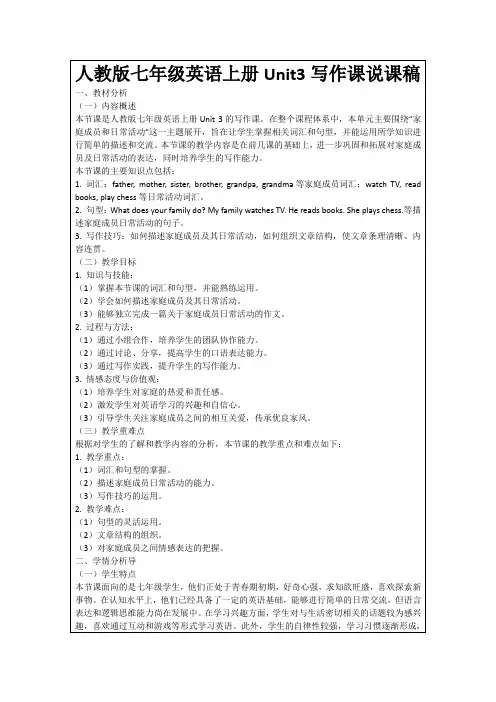
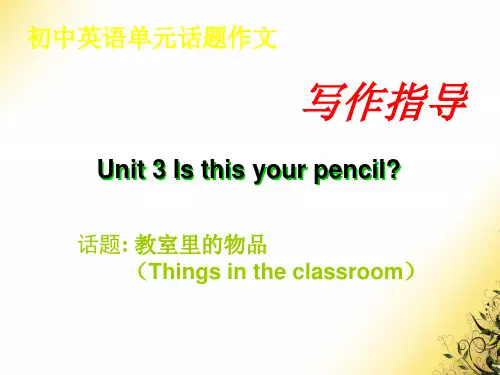
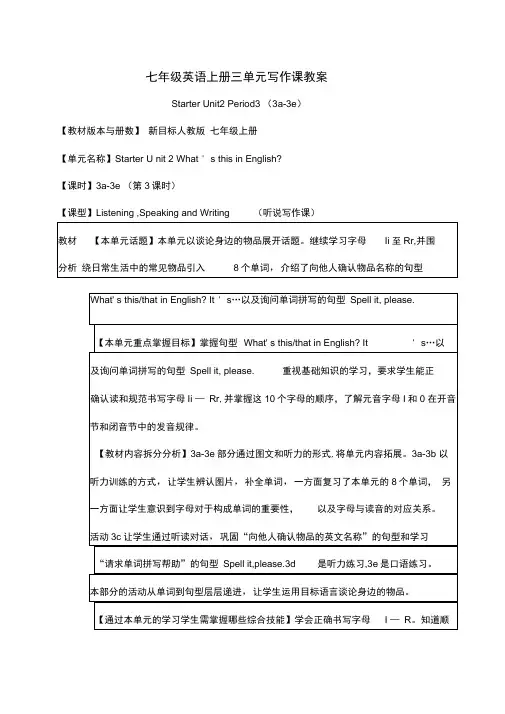

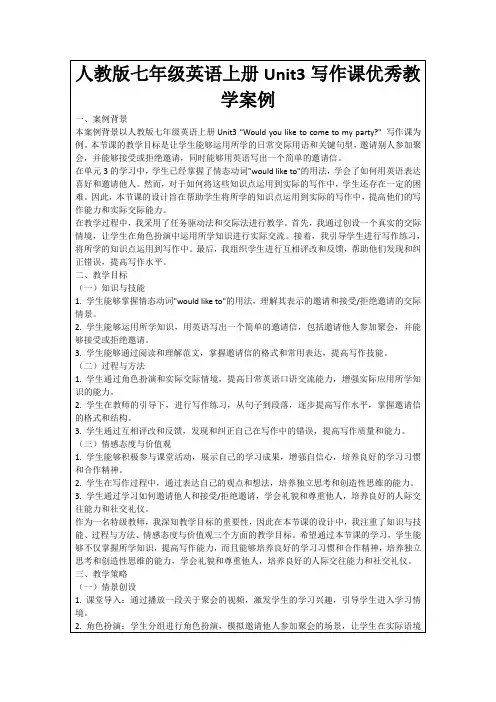
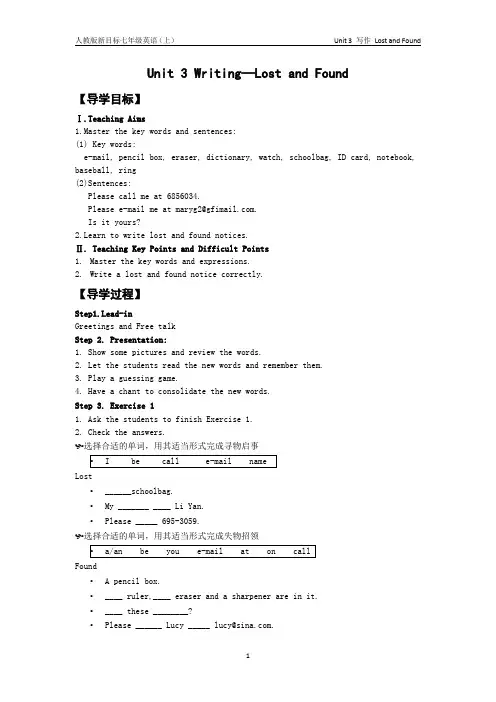
Unit 3 Writing—Lost and Found【导学目标】Ⅰ.Teaching Aims1.Master the key words and sentences:(1) Key words:e-mail, pencil box, eraser, dictionary, watch, schoolbag, ID card, notebook, baseball, ring(2)Sentences:Please call me at 6856034.Please e-mail me at maryg2@.Is it yours?2.Learn to write lost and found notices.Ⅱ. Teaching Key Points and Difficult Points1.Master the key words and expressions.2.Write a lost and found notice correctly.【导学过程】Step1.Lead-inGreetings and Free talkStep 2.Presentation:1. Show some pictures and review the words.2. Let the students read the new words and remember them.3. Play a guessing game.4. Have a chant to consolidate the new words.Step 3. Exercise 11. Ask the students to finish Exercise 1.2. Check the answers.选择合适的单词,用其适当形式完成寻物启事Lost•______schoolbag.•My _______ ____ Li Yan.•Please _____ 695-3059.选择合适的单词,用其适当形式完成失物招领Found• A pencil box.•____ ruler,____ eraser and a sharpener are in it.•____ these ________?•Please ______ Lucy _____ lucy@.Step 4. Exercise 21. Have the students read the instructions and know how to do them.2. Ask the students to finish Exercise 2.3. Check the answers.根据下面的提示,完成寻物启事今天丢失一块手表,有捡到者可打电话695-3059与David联系。
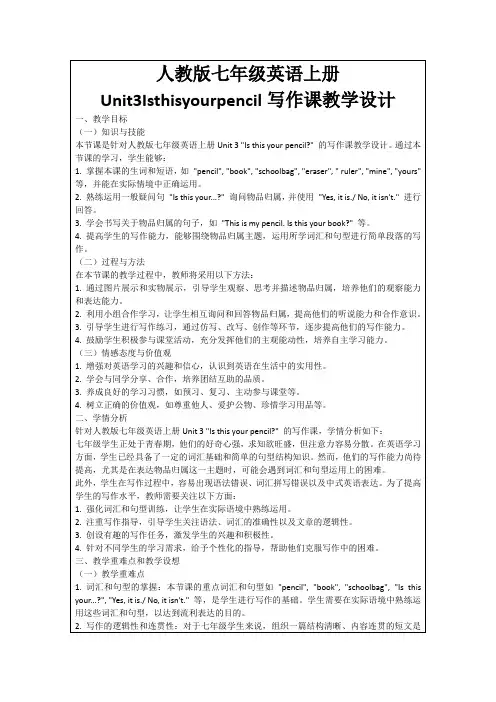
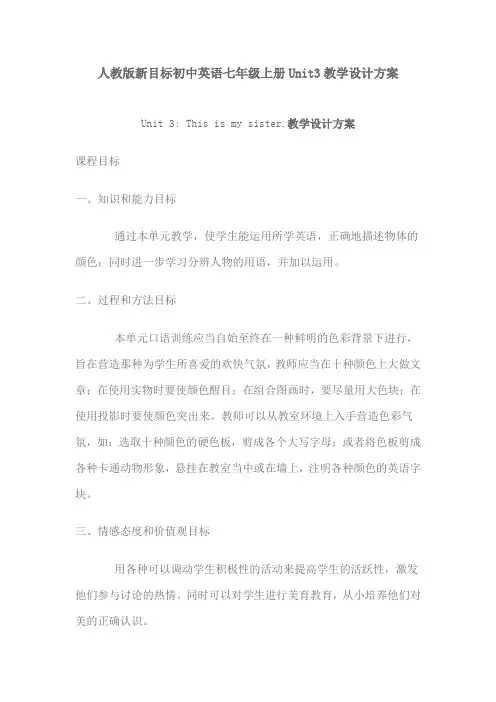
人教版新目标初中英语七年级上册Unit3教学设计方案Unit 3: This is my sister.教学设计方案课程目标一、知识和能力目标通过本单元教学,使学生能运用所学英语,正确地描述物体的颜色;同时进一步学习分辨人物的用语,并加以运用。
二、过程和方法目标本单元口语训练应当自始至终在一种鲜明的色彩背景下进行,旨在营造那种为学生所喜爱的欢快气氛,教师应当在十种颜色上大做文章;在使用实物时要使颜色醒目;在组合图画时,要尽量用大色块;在使用投影时要使颜色突出来。
教师可以从教室环境上入手营造色彩气氛,如:选取十种颜色的硬色板,剪成各个大写字母;或者将色板剪成各种卡通动物形象,悬挂在教室当中或在墙上,注明各种颜色的英语字块。
三、情感态度和价值观目标用各种可以调动学生积极性的活动来提高学生的活跃性,激发他们参与讨论的热情。
同时可以对学生进行美育教育,从小培养他们对美的正确认识。
学情分析“What color"学生在学习的过程中很容易把它错写成或错读成“What’s color”,因此在练习中要反复强调。
教学准备A tape-recorder, 一张白纸和各种颜色的彩笔四.课时安排:5课时Period 1Objectives:1.To learn to introduce people2.To learn to use this, these, thatProcedures:Step1 Warming up by studying the titleHello, class. What is this in English? Yes, it is. It is a photo. It is a photo of my sister. This is my sister. Read after me. This is my sister. 这是我的妹妹。
Now turn to page 101. Look at the words and expressions from Unit 3 and make sentences with me.This is my mother. That is my father. This is my brother. That is my friend. Etc.Step2 1a Finding and matchingPlease open your books and turn to page 13. Look at the picture in 1a. Find these people in the picture. Match the words with the people in the picture.Step3 1b Listening and circlingLook at the picture in 1a, and listen to the tape. You are going to listen to the conversation twice and circle the people in the picture. Then you shall read the conversation after the tape. One of you good at drawing shall come to draw the picture in 1a.S tep4 1c PAIRWORKTake turns to talk about your family.Here is an example in the book. First read it after me and then read it loudly several times on your own.Step5 SummaryStep6 HomeworkPeriod 2Objectives:1. To learn the names for family members2. To learn to use plural nounsProcedures:Step1 Warming up by greeting and introducingHello, class. Look at this table and number the six sentences in the same order as they come in this book.Read after me these six sentences. And make a conversation with them.Step2 2a Listening and circlingTurn to page 14. Listen to the tape. First just listen, and then listen again and circle the words you hear. Check the answers by asking two students to show their answers.Step 3 2b Listening and matchingPlease listen to the tape again and match the names with the people in the picture in Part 2b. Check the answers.Now go to page 85. Read the tapescript. While reading try to cut/ the sentence into thought groups, study all the predicates and underline all the expressions. That’s grammar study, indeed. Now let’s talk as they do in the conversation. We are going to talk in imitation of the conversation we have just heard and read. Step 4 2c PAIRWORKLet’s play a game. Student A covers the names. Ask about the people in the picture. Student B answers the questions.Now look at a photo of our class students. Make a dialogue like the one above.Step 5 SummaryStep6 HomeworkFinish off the Wb exercises of SectionA.Period 3Objectives:1.To learn to introduce people2.To learn the names for family members Procedures:Step 1 Warming up by studying the grammar focusReview the grammar focus. Go Page14 and read after me these questions and answers. Get several students to translate these sentences.Step 2 3a Reading and fillingLook at the picture on page 15. Put a word from on the left into the blank. Ask several students to write their answers down on the Bb. Check as a class.Let the Ss read the conversation .Step 3 3b PAIRWORKNow read the conversation above together with me. Then practice the conversation in pairs.Step 43c Writing and guessingNow boys and girls, let’s play a guessing game.I will ask one student to come to the blackboard to write a name on the blackboard, and the others shall guess who the person is.For example ,A:Is Guo Peng your brother? B:No, he isn’t.Draw a picture of your family member, and write some sentences to introduce your family member to your classmates.Step5 4 GROUPWORKLet’s ask and answer in groups of four. Show the others your family photos. Take turns to ask and answer questions about the photos. You have to use all the sentences patterns you learn so far. Step6 HomeworkPeriod 4Objectives:1.To learn to use subject pronoun she2.To learn to use Yes/No questions and short answers Procedures:Step 1 Warming up by asking and answeringHi, class. Let’s read these sentences and complete them with one word,.1. Your father's sister is your ___. (aunt)2. Your mother's mother is your ___. (grandmother)3. Your sister's brother is your ___. (brother)4. Your mother's brother is your ___. (uncle)5. Your uncle's son is your ___. (cousin)6. Your mother's father is your ___. (grandfather)To know more about names for family members,let’s go to page 16. Step2 1 Reading and addingFirst read after me these words on page 16 at the top.Then put the right word in the right place in the family tree. The answers should be:Could you make your own family tree? Have a try!Step3 2a Listening and checkingThis activity gives you practice in recognizing specific vocabulary words in spoken conversation. First time I play the tape, and you just listen. Then listen and check the word you hear.Step4 2b Listening and choosingLook at the pictures in 2b. Listen to the tape for the third time. This time you listen and pick the picture Dave and Lin Hai are talking about. (Picture 1)Now turn to page 85. Read the conversation and underline all the useful expressions. Copy them in your notebook after class. Step5 2c PAIRWORKBoys and girls! Look here. Look at this picture. Look at these people. They are members of my family. This is my mother. And this is my sister.Now please work in pairs to talk about your family with your family photo or a picture you draw. Get several students to talk about their family.Step6 SummaryStep7 HomeworkPeriod 5Objectives:1.To learn to use demonstratives this and these2.To learn to make and use plural nounsProcedures:Step1 Warming up by acting out the conversationsGood morning, class. Let’s go to page 8. Let’s read aloud the two conversations from this unit.Now let’s act them out in groups of four.Could we make some changes to the conversations? Let’s have a try.Step4 3a Reading and drawingOn page 17 is a letter from Emma to Mary. What does Emma say to Mary? Now read the letter after me and translate it into Chinese.Now draw a picture of Emma’s family.Next let’s read the letter again to find out and underline all the useful expressions. Copy them in your notebook after class.Step5 3b Looking and writingLook at the family photo in 3b. Suppose this is your family photo. Write about the people in the photo. Ask several students to share their answers with the class.Step6 4a Looking and writingWhere is your family photo? Now look at your photo and write a letter about it.Step7 SummaryStep8 HomeworkFinish off the Wb. exercises of Section B.。
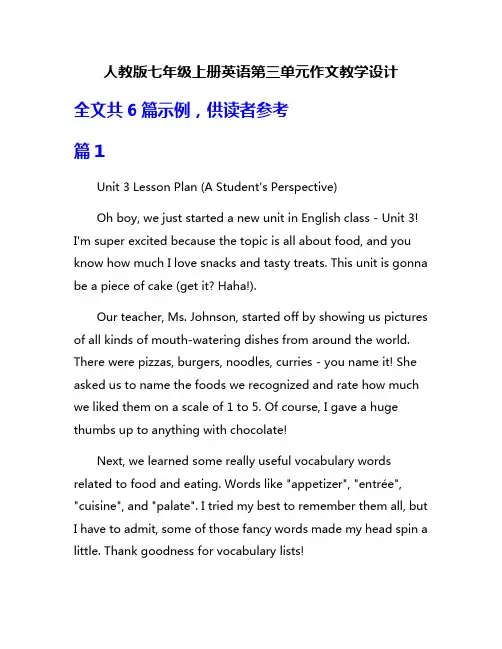
人教版七年级上册英语第三单元作文教学设计全文共6篇示例,供读者参考篇1Unit 3 Lesson Plan (A Student's Perspective)Oh boy, we just started a new unit in English class - Unit 3! I'm super excited because the topic is all about food, and you know how much I love snacks and tasty treats. This unit is gonna be a piece of cake (get it? Haha!).Our teacher, Ms. Johnson, started off by showing us pictures of all kinds of mouth-watering dishes from around the world. There were pizzas, burgers, noodles, curries - you name it! She asked us to name the foods we recognized and rate how much we liked them on a scale of 1 to 5. Of course, I gave a huge thumbs up to anything with chocolate!Next, we learned some really useful vocabulary words related to food and eating. Words like "appetizer", "entrée", "cuisine", and "palate". I tried my best to remember them all, but I have to admit, some of those fancy words made my head spin a little. Thank goodness for vocabulary lists!Then came the fun part - learning about different cultures and their traditional foods. We watched videos about Italian pasta-making, Indian spice markets, and even how chocolate is made (my favorite!). It was so cool to see how people from different parts of the world eat such diverse foods.For homework, Ms. Johnson asked us to interview our parents or grandparents about their favorite childhood dishes and cultural food traditions. I can't wait to ask my grandma about all the yummy Puerto Rican foods she used to make when she was a kid. Maybe she'll even share a recipe with me!In the next few lessons, we're going to practice ordering food at a restaurant using proper English phrases. We'll learn how to politely ask for refills, additions or substitutions to our order. I just hope nobody orders anything too stinky like durian fruit - yuck!We'll also spend some time comparing fast food tohome-cooked meals. I know fast food isn't the healthiest, but a kid can dream of unlimited fries and milkshakes, right? Ms. Johnson said we'll do activities analyzing nutrition facts and learning about balanced diets. As long as she doesn't take away my weekly pizza day, I'm cool with that.Later in the unit, we'll get to do fun food-related projects like designing our own restaurant menus and writing reviews of our favorite local eateries. I can't wait to write a scathing review of that new place that messed up my cheeseburger order. Revenge, through the power of essays!To wrap things up, our big final assessment will be giving an oral presentation about a special cultural dish or food tradition. We'll have to research the history, ingredients, and significance of the dish. I'm thinking of doing mine on s'mores because they're an amazing American camping tradition. Who doesn't love roasting marshmallows over a fire?Overall, I'm really looking forward to this delicious unit. We'll get to explore the world through food while practicing our English reading, writing, listening and speaking skills. And ifwe're lucky, maybe Ms. Johnson will even let us have a cultural food-tasting party at the end. A girl can dream, right? Now if you'll excuse me, I have to go polish off these chips before class...篇2Unit 3 - My ClassroomI can't wait to tell you about our latest English lessons! We've been learning all about describing our classroom and thedifferent objects we can find there. It's been so much fun and really helpful for improving my English skills.First up, Miss Li introduced lots of new vocabulary words related to the classroom. There were words like "desk", "chair", "blackboard", "chalk", "eraser" and so many more. We had to repeat them over and over, which was a little boring at first. But then Miss Li brought in real objects from our classroom and had us identify them using the new words. That made it way more interesting and memorable!After we learned the basic vocabulary, Miss Li taught us how to make simple sentences describing the location of different objects. We learned phrases like "next to", "in front of", "behind", "on the left/right", and "between". Then we did an activity where we had to give our classmates instructions to find specific items based on their location. It was like a treasure hunt game and we all got super competitive trying to be the first to find everything!Next up was learning adjectives to describe the characteristics of classroom objects. Words like "big", "small", "new", "old", "wooden", "metal", etc. Miss Li brought in a bunch of different desks, chairs and other things and we had to describe them using the right adjectives. There was this reallycool antique desk that must have been 100 years old! Describing that one was tough.Then we combined everything we had learned so far to create complete sentences about our classroom. Stuff like "The new metal chairs are next to the old wooden desks" or "The small green eraser is between the big books on the shelf". Writing out these descriptions was great practice for improving my English skills.But my favorite part was our final speaking activity. Miss Li put us into small groups and gave each group a different "dream classroom" scenario. My group's scenario was a classroom...in space! On a spaceship! How cool is that? We had to describe what our space classroom would look like, using all the vocabulary and grammar we had learned.My group had so much fun coming up with creative ideas. We decided our classroom would be in a big dome with a transparent ceiling so we could look at the stars during lessons. Instead of normal desks, we'd have these high-tech floating desk pads. And of course we'd have all the latest space-age teaching tools like holographic projectors and virtual reality headsets for field trips to other planets!When it was time to present our space classroom to the rest of the class, I was a little nervous. But I just imagined I was an astronaut teacher describing my futuristic classroom to the rookies. I think I did a pretty good job explaining all the awesome features, though I did mix up "left" and "right" a couple times. Whoops!Overall, this unit on describing classrooms has been excellent for building up my English skills, especially vocabulary and using adjectives correctly. I feel much more confident now giving descriptions and instructions in English. And learning all the space-related words was great preparation for my future career...as an astronaut teacher! Just kidding, but exploring other planets would be pretty cool.Up next is a unit on daily routines and schedules. I have a feeling there will be lots of useful phrases for talking about my day and the things I do at certain times. I'm already brushing up on vocabulary words like "wake up", "get dressed", "have breakfast", and so on. Cant' wait to see what fun activities Miss Li has planned! Learning English is awesome.篇3Unit 3 Writing Lesson PlanHey guys! Today I wanted to share with you the writing lesson we did in English class for Unit 3. Our teacher Ms. Wang had us work on writing a story and I thought it was really fun and helpful, so I'll explain how she taught it.First, she had us read this funny story in our textbooks about a kid who was always late for school. It was about how he overslept one morning because his alarm clock broke, and then he had all these crazy things happen to him on his way to school that made him later and later. At the end, he finally made it but was like 2 hours late! We talked about the story and answered some questions to make sure we understood everything that happened.Then Ms. Wang told us we were going to practice writing our own stories like that, with a main character and a sequence of events that leads to a conclusion or outcome at the end. She said this type of story is called a "narrative" and the important things are:Having a clear main character that the story focuses onSetting up the situation at the beginningDescribing the events that happen in a logical sequenceAdding lots of details to make it more interesting and vividBringing it to a resolution or conclusion at the endShe had us start by choosing who our main character would be - it could be ourselves or just a made-up person. I decided to make my character a kid named Mike who is always playing video games. Then we had to set up the situation, like what is Mike's regular routine and what will the initiating event be that starts getting him into trouble? I wrote that Mike's parents were going out of town and leaving him home alone for the weekend, and he got so into playing games that he made a huge mess and didn't do any of his chores.Next was the fun part - coming up with a chain of events that makes the situation worse and worse! Ms. Wang said to think of at least 4-5 major events and write them in chronological order. I had Mike first getting yelled at by his parents on a video call for not cleaning, then trying to quickly do chores but making more messes, then having to hide messes from a neighbor who stopped by, etc. For each event, Ms. Wang reminded us to add lots of descriptive details about what exactly was happening, how Mike was reacting and feeling, descriptions of the messy house, dialogue if relevant, etc.Finally, we had to come up with how the story would be resolved at the end and what the outcome was after that wholecrazy series of events. I wrote that Mike's parents ended up coming home early and he got in huge trouble, but also had a funny scene where they slip on something and make another mess, then they all have to clean together. The conclusion was Mike learning his lesson about procrastinating and making messes.After we finished drafting our narrative stories, Ms. Wang had us trade with partners and provide feedback on things like:Making sure the story events make logical sense and follow a sequenceChecking for grammar/spelling mistakesSuggesting more vivid word choices for descriptionsGiving ideas for adding more details or dialogue in certain partsThen we revised our stories based on the feedback and wrote up final drafts. On the last day, some of us got to share our stories out loud with the class!Overall, I felt like I really leveled up my narrative writing skills and made my story way more engaging and descriptive than it started. Shoutout to Ms. Wang for showing us how it's done!Writing can be hard work but it's rewarding when you craft a good story. Let me know if you have any other questions!篇4Unit 3 - Having FunHey there! It's me again, your friendly neighborhood 7th grader. Today I'm going to share my thoughts on Unit 3 from our English textbook. The unit is called "Having Fun" and boy, did we have a blast learning about it!The unit started off with a really cool text about a family visiting an amusement park. I loved reading about all the exciting rides and games they got to experience. The roller coaster sounded like an absolute thrill! I could picture myself screaming at the top of my lungs as the coaster went upside down. Though, I have to admit, I'd probably be terrified out of my mind too!After the reading, our teacher had us practice some useful sentences and vocabulary words related to amusement parks and fun activities. We learned how to express enjoyment, fear, and other emotions through simple phrases like "I'm having a great time!" and "That was scary but fun!" It's amazing how a few words can capture so much feeling.Then came my favorite part - listening to some conversations about planning a fun weekend. I really enjoyed eavesdropping on the different friend groups deciding what activities to do together. Some wanted to go to the movies, others preferred hiking or playing sports. There were so many entertaining options to choose from! It made me wish I could join in and make plans with them.Speaking activities are always a blast too. We did some fun role-plays where we had to act out making weekend plans with friends and family members. I'm a bit of a shy guy, so public speaking isn't my strong suit. But I have to admit, once I got into character, I didn't want the scene to end! It felt like I was living out my fictional weekend for real.Towards the end of the unit, we did a really cool project in groups. We had to design and pitch our own amusement park to the class, complete with ride ideas, food options, souvenirs, you name it. My group went all out with a massive indoor water park themed to an ancient civilization. We had everything from towering waterslide ruins to a lazy river representing the Nile. Maybe I have a future in amusement park design?Overall, I'd say Unit 3 was one of the most enjoyable units we've covered so far. Learning about fun activities and makingweekend plans was right up my alley as a kid. Plus, all the projects, role-plays and creative writing assignments made it so engaging. I hadn't realized how much you could cover in an English unit just from the concept of "having fun."I'm already looking forward to the next unit. Though, with my luck, it'll probably be something weird like the importance of eating your vegetables or something. A kid can dream of anall-amusement park curriculum, right? Maybe next year...篇5Here's a 2000-word lesson plan for teaching the writing section of Unit 3 in the 7th grade English textbook (PEP Edition), written from a student's perspective:Unit 3 Writing Lesson PlanHi there! Today, I'm going to share with you how our English teacher taught us to write compositions for Unit 3 in our 7th grade textbook. It was a really fun and engaging process, and by the end, I felt much more confident in my writing abilities.To start off, our teacher explained that the writing section for this unit focused on descriptive writing. She said descriptive writing is all about using vivid details to paint a picture in thereader's mind, making them feel like they're right there experiencing whatever you're describing.The first thing we did was a group brainstorming activity. Our teacher put us into small groups and gave each group a different object, like a seashell, a teddy bear, or a beautiful flower. We had to come up with as many descriptive words and phrases as we could to describe the object's appearance, texture, smell, and any other sensory details.After a few minutes, each group shared their descriptions with the class. It was really interesting to hear the different ways everyone described the same object! Our teacher praised the most creative and vivid descriptions, explaining why they were so effective.Next, our teacher did a short lesson on using descriptive language techniques like similes, metaphors, sensory details, and adjectives/adverbs. She gave examples of each technique and had us practice identifying them in sample paragraphs.Then came the fun part - we got to go outside and find something in nature to describe through writing. I chose a tall oak tree in the schoolyard. We spent about 20 minutes quietly observing our chosen subjects, jotting down notes on all the details we noticed.Back in the classroom, our teacher guided us through the process of turning our notes into complete descriptive paragraphs. We had to organize our details into an intro, body paragraphs, and a conclusion. The intro had to capture the reader's interest, the body gave vivid descriptive details, and the conclusion wrapped things up nicely.As we were writing, our teacher circulated and gave us personalized feedback. She reminded us to "show, not tell" by using lots of sensory descriptions instead of bland statements. She also encouraged us to use figurative language like similes and metaphors.Once we had a draft done, we did a "peer review" where we swapped papers with classmates and gave each other constructive criticism. I got some great suggestions for improving my descriptive language and fixing some grammatical errors.After revising our drafts based on the feedback, we handed them in to our teacher to get a grade and final comments. I was really proud of my descriptive paragraph about the oak tree!A week later, our teacher returned our graded papers. She went over some of the highest-scoring examples, explainingwhat made them so effective. Hearing the awesome descriptions my classmates wrote was really inspirational.For the final assignment, our teacher told us to write a descriptive essay of 3-5 paragraphs about a person, place, or object that was special or meaningful to us. We could choose anything, as long as we used plenty of descriptive language to make it come alive.I decided to write about my grandma's cozy living room, describing all the sights, smells, textures, and feelings of warmth and comfort I experience when I visit her. Using all the techniques we'd learned, I tried to transport the reader right into that special place.After turning in our essays, some students even volunteered to read theirs aloud to the class. It was amazing hearing the variety of perspectives and the levels of detail everyone included.Overall, this descriptive writing unit helped me improve my observation skills, vocabulary, and ability to craft vivid imagery with words. Our teacher made the lessons interactive and fun. I can't wait to continue developing as a writer!Well, that's a wrap on my behind-the-scenes look at our Unit 3 writing lessons! Let me know if you have any other questions.Writing may seem intimidating at first, but breaking it down into manageable steps makes it so much easier. Just look around you, observe closely, and let your words paint a picture. Happy writing!篇6Teaching Essay Writing in Unit 3 (A Student's Perspective)Wow, Unit 3 is all about writing essays! I was kinda nervous at first, but Miss Lee made it really fun and easy to understand. She started by explaining why essays are important. Turns out, being able to write good essays helps us share our thoughts and ideas clearly with others. It's a super useful skill for school, work, and life in general.The first thing we learned was the basic structure of an essay. Miss Lee said every essay needs to have three main parts: an introduction, body paragraphs, and a conclusion. She compared it to a burger - the introduction is the top bun, the body paragraphs are the patties and fillings, and the conclusion is the bottom bun. Cute analogy, right?For the introduction, Miss Lee taught us to start with a hook to grab the reader's attention. It could be an interesting question, fact, or quote related to the essay topic. Then we need to givesome background information to set the context. Finally, the introduction should end with a clear thesis statement that tells the reader what the essay will be about.Next up were the body paragraphs, which Miss Lee called the "meat" of the essay. Each body paragraph should focus on one main idea that supports the thesis statement. We learned to start with a topic sentence that introduces the main point, then give supporting details and examples to back it up. Miss Lee emphasized using transition words like "firstly", "additionally", and "moreover" to link our ideas smoothly.The conclusion is the last bite of the burger, wrapping everything up nicely. Here we need to restate the thesis in different words and summarize the key points from the body paragraphs. Miss Lee also suggested ending with athought-provoking question or call to action to leave a lasting impression on the reader.But writing isn't just about following a formula. Miss Lee made sure we understood the importance of having a clear purpose, organizing our thoughts logically, and using vivid examples to support our arguments. She taught us brainstorming techniques like mindmapping and freewriting to explore our ideas before drafting the essay.We also learned about different types of essays, like argumentative, descriptive, and narrative essays. Each type has its own strengths and purposes. For example, argumentative essays aim to convince the reader of a particular viewpoint, while descriptive essays paint a vivid picture using sensory details.Once we had the basics down, it was time to practice! Miss Lee gave us lots of fun prompts and topics to write about, like "Describe your dream school" or "Should kids have a longer summer break?" I really enjoyed the creative writing exercises where we got to use our imagination.My favorite part was the peer review sessions. We formed small groups and took turns sharing our drafts, giving feedback on clarity, structure, and ideas. I found it super helpful to get different perspectives from my classmates. It helped me see areas I could improve and gave me confidence in my writing abilities.Towards the end of the unit, Miss Lee taught us about editing and revising our work. We learned to watch out for common errors like spelling mistakes, run-on sentences, and passive voice. She emphasized the importance of proofreading carefully and making sure our essays flowed logically and naturally.On the last day, we had an "essay cafe" where we could dress up, sip juice boxes, and share our polished essays with the class. It was so much fun to see everyone's creativity and hard work on display! I felt really proud of the descriptive essay I wrote about my awesome summer camping trip.Overall, I'm so glad we covered essay writing in Unit 3. Miss Lee made it interesting and practical, breaking down the process into easy-to-follow steps. I used to find essays intimidating, but now I feel confident in my ability to express my thoughts and ideas clearly in writing. Bring on those college application essays - I'm ready!。

人教版新目标七年级英语初一上册Unit3单元教案设计Unit 3Is this your pencil?第一课时Section A (1a~1c) 教学设计知识目标课堂环节§自主学习案◎新词自查根据句意和汉语提示完成句子。
1.That is his pencil (铅笔).2.—Is this your schoolbag (书包)?—No,it isn't.3.It's my book (书).4.What color is the eraser (橡皮)?5.Is that his dictionary (字典)?§课堂导学案Step 1准备与热身(Preparation)Learn the chant.T:Let's sing the chant together.my 是我的,your是你的,男的他是his,女的她是her;名词前面常站岗,限定所属有功劳。
(This activity warms up the students as well as provides review of the possessive adjectives.)Step 2呈现与输入(Presentation)1.Present the new words.Teacher shows some real school things to students and asksome questions about them to help students to learn the new words.2.Practice the new words.T:Now,please look at the picture in your books.Can you put the words with the objects in the right pictures?Write the letters next to the words,please.(Give Ss about two minutes to finish 1a.)Then check the answers.Ss:…(This activity introduces the names of some common personal possessions.)Get students to practice conversations and communicate with each other using the following sentences:What't this/that in English? It's a/an…—Is this/that your…?—Yes,it is./No,it isn't.—Is this/that his/her…?—Yes,it is./No,it isn't.Step 3练习与体验(Practice)Play the tape of 1b,get students to listen and number the conversations,then finish the teaching task of 1b.Step 4运用与生成(Production)T:Let's read the conversations together,paying attention to the pronunciation and intonation.Then leave students several minutes for them to practice the conversations.Encourage them to make their own conversations using the school things in the classroom in pairs.Finally,invite some pairs to act out their conversations.Step 5巩固与提高(Progress)【探究点】Is that your schoolbag? 那是你的书包吗?Is this/that…?是一般疑问句,意为“这/那是……吗?”回答时要用yes(是) 或no(不是), 且答语中要用it 代替this 或that, 即Yes,it is./ No,it isn't.【针对训练】—Is this his pencil?—__C__.A.Yes,it's B.Yes,it's my pencil C.No,it isn't D.This is his pencil【探究点】—Are these your books? 这些是你的书吗?—No,they aren't.They're hers.不,不是。
初一英语上册英语教案写作训练案例写作训练案例随着全球化进程的不断推进,英语作为世界上最为通用的语言之一,日益受到人们的重视。
尤其是在中国,由于中国与世界的交流日益频繁,很多人都认识到学好英语的重要性。
而英语教学中的写作学习尤为重要,如何提高初中学生的英语写作能力,是教师们不断思考的问题。
本文将从“初一英语上册英语教案-写作训练案例”入手,就如何通过教材给学生提供写作训练打下基础,提高学生的写作能力进行探讨。
一、教材指导1.教材分析教材是老师教学的重要依据,初一英语上册教材从语法、词汇、听说读写等方面为学生提供了丰富的英语知识。
而对于写作的教学,教材也提供了一定的指导。
比如在第二单元中就有一篇有关介绍自己的作文写作指导,此外,在第三单元中也提供了一篇关于介绍家人的作文写作指导。
这些指导,可以引导学生从生活中的具体问题切入,作文材料来源具有可操作性。
2.教材运用在教学过程中,教师可以有意识地利用教材中的写作指导来提高学生的写作能力。
比如,在介绍自己的作文写作指导中,老师可以提供些常用的英语句型,比如一些介绍人物的手段,如what,who,where等让学生熟悉和掌握。
而在介绍家人作文写作指导中,可以引导学生从家人的性格、爱好、工作等方面来介绍家人,丰富材料来源,提高写作水平。
二、互动讲解1.互动讲解的意义互动讲解是一种有效的教学方式,其意义体现在以下几个方面:(1)能让老师和学生之间的教学互动更加紧密;(2)能够在帮助学生掌握知识的同时,增强学生的自主学习能力;(3)能够在情境化教学的基础上,帮助学生将所学知识应用于实际生活中。
2.互动讲解的方式互动讲解有很多种方式,可以是小组讨论或合作学习,也可以是板书讲解和ppt讲解等。
在教学中,老师可以根据教学内容和学生的学习情况,灵活运用互动讲解的方式。
对于初一英语的写作训练来说,老师可以利用小组讨论的方式来进行,将学生分组,让学生先自己思考写作主题,然后再向小组成员介绍自己的主题想法,通过小组互动分享,来促进思维交流与碰撞,共同提高写作能力。
人教新目标英语七年级上册Unit 3 Is this your pencil?(Section B 1a—2c) 教学设计一.教材分析本节以school things为话题,主题是“确认物品的所有权”,物品主要围绕着教室内学生身边的常用物品,学会写招领启事和寻物启事,在教学时老师能够使用实物进行教学,增强学生的学习效果。
二.学情分析七年级学生学习英语的特点:初一学生对英语既感到新鲜又有所畏惧,他们希望在新的环境中通过学好英语这门新科目来获得他人的认可。
三.教学重点(1)词汇:baseball,watch,computer,game,card,notebook,ring,bag,in,library,ask,find,some,classroom,email,at,call,lost,must(2)句型:—What's this?—It's a watch.—How do you spell it?—WATCH.Ask the teacher for it.I lost my school ID must find me at 6856034.四.教学难点1.让学生能够熟练运用所学知识进行完整的对话练习。
2.让学生能够看懂寻物启事和失物招领启事。
五. 教学目标1.熟练掌握以下句式:(1) What’s this/that(in English)? It’s a/an…(2) Is this your pencil? Yes, it is. It’s my pencil. /No, it isn’t. It’s his.2.要求会写“失物招领或寻物启示”。
六.教学步骤Step 1:Greetings and talkingS1:What's this?S2:It's a pencil.S1:How do you spell it?S2:PENCIL.S1:Is this yours?S2:Yes,it 's mine.Step 2:Check the homeworkStep 3:Present the new wordsT:Excuse me,this your pencil?S1:Yes,it's mine.T:And is this your watch?S1:No,it's Bob's.T:What's this?S1:It's a watch.T:How do you spell it?S1:W ATCH.Step 5:Listening1.课本1c的处理。
人教版七年级上册作文教学专题系列练习
及辅导教案全册
课程目标
本课程旨在通过一系列练和辅导教案,帮助学生掌握基本的作
文写作技能,包括但不限于提高写作的表达能力,加强语言文字功底,提高阅读理解和写作水平,培养学生的写作兴趣和文学素养,
以便以后能够更好地应对各种写作挑战。
内容概述
本教材分为两部分:练和辅导教案。
其中,练部分包含了常见
的各种写作形式,例如议论文、说明文、记叙文等等,以及不同主
题下的写作练,每个练都配有详细的题目和解答,帮助学生逐步掌
握不同写作形式的技巧和方法。
辅导教案部分则提供了针对性的写
作辅导,包括针对不同写作难点的指导、范文解析以及常见错误的
纠正等等,帮助学生进一步提高自己的写作水平。
教学方法
本课程采用课堂教学和作业指导相结合的教学方法。
在课堂上,老师将通过讲解、示范和练等方式,帮助学生掌握各种写作形式的
技巧和方法,并指导学生进行实践操作。
在课外,学生将通过辅导教案中的指导和练,进一步巩固和提高自己的写作水平。
总结
本教材全面、详细地介绍了如何写好各种作文,为中学生的写作提供了指导和帮助。
通过本教材的学习和实践,在提高写作水平的同时,也能够培养学生的文学素养和创造性思维能力,为其未来的学习和工作打下坚实的基础。
写作训练课
学科英语
年
级
七
年
级
主备人
单位
姓名
课题
Where’s my schoolbag ?
教学目
标
教学重点
用英语流利的表述物品放置的位置,会用英语介绍自己房间里物品摆放的位置。
教学难点
用英语流利的表述物品放置的位置,会用英语介绍自己房间里物品摆放的位置。
教具准
备
1. 自编学案
2. 照片
3. 图片
4. 纸笔及小黑板
课时安
排1课时
教学过程Step 1: Free talk
(拿出自己房间的照片或自己所画的房间图片)以My room 为主题在小组内进行两两对话,介绍自己房间里物品摆放的位置,活跃课堂气氛,为引出本节课的写作话题做准备。
(2分钟)
为范文在全班朗读,从构思、布局到语言、语法的运用等方面做充分的肯定,并张贴。
要求其他同学进行对照,对自己的写作内容进行反思并改正。
Step 9: Summary
反思总结:各小组长总结本节课各同学在写作方面遇到的困难和写作中所出
现的问题并做好记录。
Where’s my schoolbag ?
板
书
设
计
教
后
反
思。
写作训练课
学科英语
年
级
七
年
级
主备人
单位
姓名
课题
My family
教学目
标
教学重点1. 学会用英语介绍家人的基本情况。
2. 使段落和句子前后连贯,相互呼应,有一定的逻辑性。
教学
难点
使段落和句子前后连贯,相互呼应,有一定的逻辑性。
教具准备1.一篇与家庭介绍的有关例文。
2.制作课件和教案。
3.准备实物投影仪、多媒体设备
课时安
排1课时
教学过程Step1. Lead-in
T: How many people are there in your fam ily?
S: There are four/th ree/five people.
T: Who are they?
S: They are …
Step2. Talk about this family with all the students in our class .
My family
There are five people in my family. They are my grandmother, my father, my mother, my sister and I. My grandmother is old .She is 68.My father is an engineer, he is 40 years old .He likes listening to music and dancing. My mother is a housewife. She likes knitting sweaters. My sister is a student. She likes eating. I am a student, too. I like reading books and playing violin(小提琴).This is my family. I love family.
Get the students to answer the questions:
1. How many people are there in “my” family?
2. What are they doing?
3. How old are they ?
4. What do they like to do?
Step3. Decide on the ou tline of this writing.
通过这篇小短文讨论小作文的基本架构,一般有几方面的介绍。
Step4. Use your own words to say these questions of your family: 1. Tell us these four questions in your real life.
1) How many people are there in your family?
2) What are they doing?
3) How old are they?
4) What do they like to do?
2. Talk about your family with your partner.
3. Then write them down on your notebooks.
Step 5.Avoid writing Chinese-English.
Let the students read their writings, and find out some Chinese-English sentences and correct them. Talk with them.
Step 6. Practice:
Ask the students to write down the outline according to the followin g: Topic:________
Main things:
①______②______③_____
Step 7.Homework: Hand in .交上一篇自己修改好的短文。
My family
板
书
设
计
教
后
反
思。